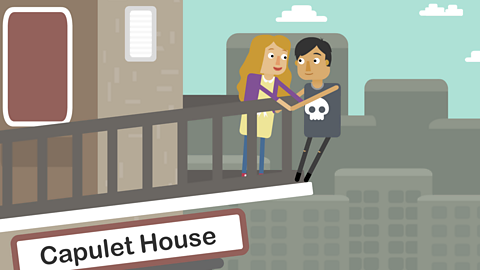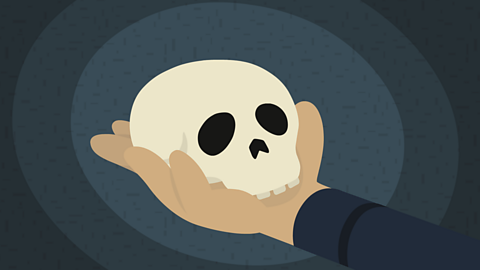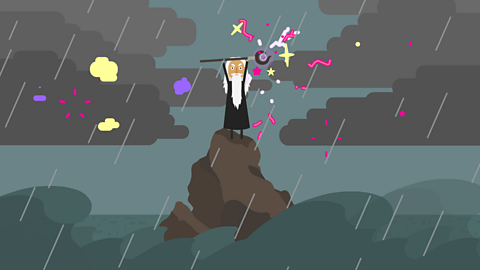Over in the land of Illyria
ItтАЩs the funniest thing that youтАЩll ever hear
A case of mistaken identity
Lessons in cross-dressing and fighting a-plenty
If music be the food of love play on (DonтАЩt stop!) (Oooh yeah) (hey!)
A criss-crossing of love and a muddling up
And the whole mad show rolls on!
ViolaтАЩs shipwrecked, thinks sheтАЩs lost her twin
тАЬIтАЩm scared to live alone as a girl тАУ whereтАЩs Sebastian??!!
I know! IтАЩll disguise as a bloke
тАЬWait, I need a name (hmmmmтАж) Cessario!тАЭ
I hope I can cope, I can go work for Orsino
The duke, тАЬIтАЩm a fella (yo!) for all he knowsтАЭ
ThereтАЩs a bit of a problem with ViolaтАЩs plan
She falls madly in love with this man
But heтАЩs in love with Lady Olivia
His love's not returned so Viola goes to visit her
And woo her for him, See she has many admirers
But sheтАЩs not bothered, sheтАЩs sad, her brotherтАЩs just died
Now Olivia doesnтАЩt know ViolaтАЩs not a bloke
And (oh no!) falls in love with тАШCesarioтАЩ
So, Orsino loves Olivia, Viola loves Orsino
Olivia loves Cesario, it's far from ideal yo!
If music be the food of love, play on (donтАЩt stop!) (Oooh yeah!)
Falseness and faking, the pranks that are made
Emotions, disguises that get in the way (Hey!)
If music be the food of love play on (donтАЩt stop!) (Oooh yeah!)
A criss-crossing of love and a-muddling up
And the whole mad show rolls on!
At OliviaтАЩs estate yeah thereтАЩs mischief afoot
Sir Toby, Sir Andrew, the rowdiest drunks,
TheyтАЩre making noise, waking up the house
Malvolio, the steward tells them off for being too loud
They decide to play a prank on him
Maria fakes a love letter and hands it to him
He performs in yellow stockings and cross-gartered laces
Later on the crew lock him up like he was crazy
Sir Andrew is jealous of OliviaтАЩs love
For тАШCesarioтАЩ, and challenges him to a fight
What a fright! Cesario hasnтАЩt fought before
See itтАЩs not easy being a man, not at all!
If music be the food of love, play on (DonтАЩt stop!) (Oooh yeah!)
Falseness and faking, the pranks that are made
Emotions, disguises that get in the way (Hey!)
If music be the food of love play on (donтАЩt stop!) (Oooh yeah)
A criss-crossing of love and a-muddling up
And the whole mad show rolls on!
ViolaтАЩs twin, SebastianтАЩs alive you know
He finds Olivia who thinks heтАЩs Cesario
She proposes to him, declaring her love
HeтАЩs confused but agrees тАШcause she looks pretty good
Orsino is mad, see he believes
Cesario is married to the girl of his dreams
Olivia sees Cesario, thinks it's Sebastian
But тАШcourse Cesario denies OliviaтАЩs ever married him!
Eventually Sebastian and Viola are united
He reveals her true self and everyoneтАЩs enlightened
They canтАЩt believe their eyes, it was a girl in disguise!
The Duke proposes to Viola, the madness is over!
If music be the food of love, play on (DonтАЩt stop!) (Oooh yeah!)
Falseness and faking, the pranks that are made
Emotions, disguises that get in the way
If music be the food of love, play on (donтАЩt stop!) (Oooh yeah)
A criss-crossing of love and a-muddling up
And the whole mad show rolls on!
Video summary
An animated version of William ShakespeareтАЩs тАЬTwelfth NightтАЭ in a retelling of the classic play set to modern music.
The twins Viola and Sebastian are separated in a shipwreck.
Fearing that Sebastian is dead, Viola disguises herself as a boy, calls herself Cesario and takes up service with Duke Orsino.
She falls in love with him but cannot do anything about it because of her disguise.
She also discovers that Orsino has fallen in love with Olivia but, following the death of her brother, she rejects him.
Orsino sends Viola to Olivia to try and win her round but, thinking Viola is a boy, Olivia falls in love with him.
Meanwhile OliviaтАЩs steward, Malvolio, is trying to keep order in the house but, her uncle Sir Toby Belch and his friends have other ideas.
They convince Malvolio that Olivia is in love with him and make him look extremely foolish тАУ Olivia thinks her servant has actually gone mad.
When she sees Sebastian, who has survived the shipwreck, she naturally thinks he is Cesario and promptly marries him.
Orsino is furious when he finds out but, once Viola and Sebastian meet and reveal their true identities, there is a happy ending тАУ for everyone but poor Malvolio.
This is from the series: Shakespeare in Shorts.
Teacher Notes
Key Stage 2:
This clip could be used as an introduction to the play, consolidation of key aspects or for revision of the plot and characters.
It could also provide a springboard for pupils to write their own modernised versions of this or another Shakespeare play perhaps using music or linked to developing artwork.
Key Stage 3:
This clip could form the basis for some improvisation work by students or for learning and delivering sections of text.
It could also be used as a stimulus for creative writing tasks involving the inner thoughts of specific characters.
This clip will be suitable for teaching English at KS2 and KS3 in England, KS3 and English Literature GCSE in Wales, KS1, KS2 and KS3 in Northern Ireland and 2nd, 3rd and 4th level in Scotland.
English KS2 / KS3: 'Romeo and Juliet' by William Shakespeare - (animation) video
A retelling of the classic play set to modern music.

English KS2 / KS3: 'Macbeth' by William Shakespeare - (animation) video
A retelling of the classic play set to modern music.

English KS2 / KS3: 'Hamlet' by William Shakespeare - (animation) video
A retelling of the classic play set to modern music.

English KS2 / KS3: 'A Midsummer Night's Dream' by William Shakespeare - (animation) video
A retelling of the classic play set to modern music.

English KS2 / KS3: 'The Tempest' by William Shakespeare - (animation) video
A retelling of the classic play set to modern music.

╠¤